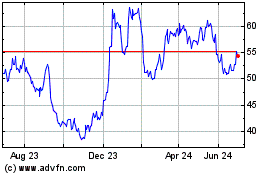Dow Jones and S&P 500 Slump Again as Russia-Ukraine War Intensifies
March 13 2022 - 12:18PM
Finscreener.org
Major indices such as the
S&P
500, Dow Jones
Industrial Average, and
the NASDAQ slumped
for the fifth straight week. While the S&P 500 fell 2.9%,
the NASDAQ and DJIA declined by 2% and 3.5%, respectively, in the
week ended on March 11 as investors remained cautious of the
ongoing war between Ukraine and Russia.
Alternatively, Russian President
Vladimir Putin
stated certain positive shifts occurred in talks
between the two countries. Right now, a ceasefire is not on the
cards, while Ukraine President Volodymyr Zelenskyy claimed the
country achieved a strategic turning point in the war. Meanwhile,
U.S. President Joe Biden rallied to call for an end to Russia’s
status as a preferred trade partner and the U.S. Congress passed a
bill to provide Ukraine with $14 billion in financial
aid.
According to Bank of America,
stock declines related to the war may have bottomed. In a CNBC
report, Bank of America analyst Savita Subramanian explains, “The
S&P 500′s -12% decline from its peak suggests much of the
froth has been taken out. Stocks are largely pricing in the
geopolitical shock, where the S&P 500 fell 9% from
peak-to-trough since Russia-Ukraine headlines in early Feb, similar
to a typical 7-8% fall in prior macro/geopolitical
events.”
Crude oil, copper, and nickel prices surge
higher
The geopolitical tensions
continue to drive prices of oil and other commodities higher. West
Texas Intermediate crude which is the U.S. benchmark gained 2.9% to
$109 per barrel while the international standard Brent crude also
rose 2.9% to $112.
While several metal prices fell
sharply, copper gained pace in the last week. Last Tuesday, nickel
prices spiked by an astonishing 250% to more than $100,000 per ton.
Russia produces 17% of the global nickel supply which has led to
fears of commodity shortages.
Around 75% of the nickel supply
is mixed with chromium to derive stainless steel which is used in a
variety of appliances. Its used in electric vehicle batteries as
well and the input costs for a single EV increased by $1,000 last
week.
Data expectations remain vulnerable
The University of Michigan’s
consumer sentiment index reduced to 59.7 in March, compared to 62.8
in February. It was the weakest print in the last 11 years. The
consumer confidence moved lower as households are now worried about
rising inflation rates as well as fears about an economic
slowdown.
Further, investors will be eyeing
an increase in interest rates by the Federal Reserve. According to
analysts, the Fed is on track to hike interest rates by 0.25% which
will be the first of multiple increases in 2022. The central bank
will reveal its outlook for interest rates and inflation for the
rest of 2022 as well.
In addition to interest rates,
the producer price index, retail sales data, and existing home
sales will be released in the next week.
Rivian stock falls by more than 7%
Shares of electric car
giant, Rivian (NASDAQ:
RIVN) nose-dived by 7.6%
on Friday after its missed Q4 estimates with respect to earnings
and revenue. The company shocked investors and analysts a few days
back after it increased prices by 20% for pre-orders. The backlash
on social media sent the stock lower which is now down 78% below
record highs.
DocuSign (NASDAQ: DOCU)
stock also fell by 20% after it issued weak guidance for Q1 and
fiscal 2023, ending in January. Company management forecast sales
to grow by 18% to $2.48 billion in fiscal 2023 which is lower than
Wall Street estimates of $2.61 billion.
DocuSign (NASDAQ:DOCU)
Historical Stock Chart
From Mar 2024 to Apr 2024

DocuSign (NASDAQ:DOCU)
Historical Stock Chart
From Apr 2023 to Apr 2024
